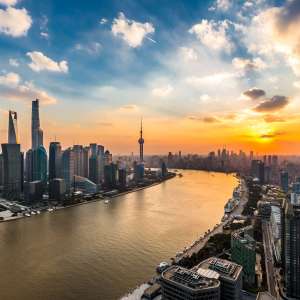A Comprehensive Guide to Shipping from Yangshan Ocean Port to the US
Latest update on 25 July, 2024 by Angelina Pang– Marketing Analyst at FreightAmigo
Freight transportation is a vital component of global trade, and the Yangshan Ocean Port in China plays a crucial role in this ecosystem. As the world’s busiest container port, Yangshan is a key departure point for goods being shipped to the United States. In this article, FreightAmigo aims to provide a comprehensive guide to shipping from Yangshan Port to the US, covering essential aspects such as the logistics involved, the regulations governing this trade route, and strategies to ensure smooth and efficient shipping.
Want to Instantly Compare International Express, Air, Sea, Rail Freight And Truck Logistics Management Solutions To Control Transportation Costs?
Logistics of Freight from Yangshan to the US
Understanding the Supply Chain
The supply chain from Yangshan Ocean Port to the US is a complex network involving multiple stakeholders, including manufacturers, shipping companies, customs authorities, and logistics providers. The process begins with the consolidation of goods at the port. Here, containers are loaded onto massive cargo ships, each capable of carrying thousands of containers. These ships then embark on a trans-Pacific journey that typically takes around two to three weeks, depending on the specific route and weather conditions.
Upon arrival in the US, the containers are offloaded at major ports such as Los Angeles, Long Beach, or Seattle. From these ports, goods are distributed across the country via rail and truck networks. Efficient management of this supply chain is crucial to minimize delays and costs, and it often involves sophisticated tracking systems and coordination between various parties.
Key Players in the Freight Process
Several key players are involved in the freight process from Yangshan to the US:
- Shipping Lines: Companies like Maersk, MSC, and COSCO operate the vessels that transport containers across the Pacific.
- Freight Forwarders: These intermediaries help manage the logistics of shipping, including booking cargo space, handling documentation, and arranging inland transportation.
- Customs Brokers: They assist in navigating complex customs regulations, ensuring that all necessary paperwork is for the smooth clearance of goods at both departure and arrival points.
- Port Authorities: Entities managing the operations at both Yangshan and US ports, ensuring that loading and unloading processes are efficient and secure.
By understanding the roles of these players, businesses can better coordinate their shipping operations and mitigate potential bottlenecks in the supply chain.
Regulatory Considerations
Export Regulations from China
Exporting goods from China involves adhering to a stringent set of regulations. Chinese customs authorities require detailed documentation, including export licenses, commercial invoices, packing lists, and certificates of origin. Failure to comply with these requirements can result in delays, fines, and even the confiscation of goods.
It is essential for exporters to stay updated on any changes to these regulations and to work closely with customs brokers who are well-versed in Chinese export laws. Additionally, understanding the classification of goods according to the Harmonized System (HS) codes is crucial, as these codes determine the applicable duties and taxes.
Import Regulations in the US
On the US side, import regulations are equally rigorous. The US Customs and Border Protection (CBP) agency oversees the importation of goods and enforces compliance with various federal laws. Importers must file an Importer Security Filing (ISF), commonly known as the “10+2” rule, which requires detailed information about the shipment to be submitted at least 24 hours before the cargo is loaded onto the vessel.
Other key documents include the bill of lading, arrival notice, and entry summary. Importers must also ensure that their goods comply with regulations set by other federal agencies, such as the Food and Drug Administration (FDA) for food products and the Environmental Protection Agency (EPA) for chemicals.
Non-compliance with US import regulations can lead to severe penalties, including the seizure of goods and hefty fines. Therefore, importers must work with experienced customs brokers and stay informed about regulatory changes.
Strategies for Efficient Shipping
Choosing the Right Shipping Service
Selecting the appropriate shipping service is crucial for efficient freight transportation. There are several options available, each with its advantages and disadvantages:
- Full Container Load (FCL): This option is ideal for large shipments that can fill an entire container. It offers faster transit times and reduced handling, which can minimize the risk of damage.
- Less than Container Load (LCL): Suitable for smaller shipments that do not require a full container. While it is cost-effective, it may involve longer transit times due to the consolidation process.
- Air Freight: For time-sensitive shipments, air freight offers the fastest transit times but at a significantly higher cost compared to ocean freight.
Businesses should assess their specific needs, including budget, shipment size, and delivery timelines, to choose the most appropriate shipping service.
Leveraging Technology for Supply Chain Efficiency
Technology plays a pivotal role in modern freight logistics. Advanced tracking systems enable real-time visibility of shipments, allowing businesses to monitor the status of their goods throughout the supply chain. This visibility helps in identifying potential delays and taking proactive measures to mitigate them.
Moreover, digital platforms and software solutions can streamline documentation processes, reducing the risk of errors and ensuring compliance with regulatory requirements. Automation of routine tasks, such as inventory management and order processing, can further enhance efficiency and reduce operational costs.
Investing in these technological solutions can significantly improve the overall efficiency of the shipping process, leading to faster delivery times and higher customer satisfaction.
Conclusion
Freight transportation from Yangshan Ocean Port to the US is a multifaceted process involving various stakeholders, stringent regulations, and sophisticated logistics. With FreightAmigo’s guidance on understanding supply chain dynamics, complying with export and import regulations, and leveraging technology, businesses can ensure efficient and cost-effective shipping. As global trade continues to evolve, staying informed and adaptable will be key to maintaining a competitive edge in the international marketplace.
If you are looking for logistics experts, please visit FreightAmigo Page
Read More:
Shipping from Prince Rupert Port to Hong Kong | FreightAmigo
Shipping from Vancouver to Hong Kong | FreightAmigo
A Guide to Freight From Shekou to Cambodia | FreightAmigo
If you have any inquiries on logistics / supply chain, feel free to contact FreightAmigo now:
Chat with us online | Hotline: +852 28121686 | WhatsApp: +852 27467829









































